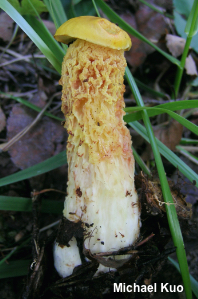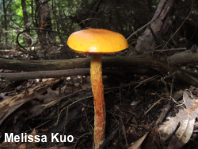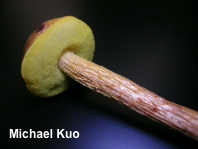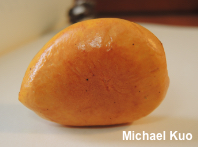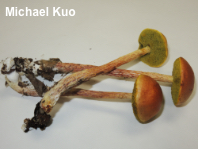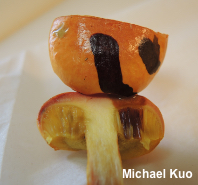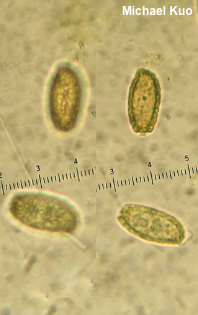| Major Groups > Boletes > Pitted/Ridged-Spored Boletes > Aureoboletus betula |

|
Aureoboletus betula [ Basidiomycota > Boletales > Boletaceae > Aureoboletus . . . ] by Michael Kuo This beautiful bolete has an amazing stem that is deeply, coarsely reticulate and, when the mushroom is in the "button" stage, often as wide as, or even wider than, the cap. With development the stem stretches out dramatically, becoming quite long. The sticky cap is reddish to yellow or orange, and the non-bruising pore surface is yellow, becoming slightly greenish with age. Under the microscope, Aureoboletus betula features finely pitted spores. It is found under oaks, or in mixed woods of pine and oak, primarily in the southern Appalachians. Austroboletus betula, Boletellus betula, Boletus betula, and Heimioporus betula are previous names. Recent DNA results (Kuo & Ortiz-Santana 2020) support placement in Aureoboletus. Description: Ecology: Mycorrhizal with oaks (and perhaps other hardwoods and/or pines), especially in mixed pine-oak woods; growing alone or scattered; summer and fall; fairly widely distributed from Michigan and Pennsylvania to the southeastern United States and Mexico, but more common in the southern Appalachian Mountains. The illustrated and described collections are from Ohio. Cap: 2–5 cm; convex, becoming broadly convex; sticky; bald; bright golden yellow becoming brownish yellow—or reddish to orange-yellow; the margin a little incurved. Pore Surface: Bright yellow, maturing to greenish yellow; depressed at the stem by maturity; not bruising; 1–2 angular pores per mm at maturity; tubes to 1.5 cm deep. Stem: 10–15 cm long; 1–2 cm thick; equal above a slightly swollen base; coarsely and deeply lacerated-ridged or lacerated-reticulate; yellow near apex; below yellowish to whitish, with yellow to reddish ridges; base often slightly curved and rooting; basal mycelium white and prominent. Flesh: Yellow in cap; pinkish under the cuticle; whitish in stem; stem midportion staining pinkish on exposure. Odor and Taste: Not distinctive. Chemical Reactions: Ammonia pale green on cap; negative on flesh. KOH deep blackish red on cap and pore surface; brownish on flesh. Iron salts black on cap; negative on flesh. Spore Print: Olive. Microscopic Features: Spores 16–24 x 7–12 µm; ellipsoid, sometimes with one end a little truncated; finely punctate, evident with focus applied to spore surface; appearing to have chambered walls otherwise; golden in KOH. Basidia 4-sterigmate; 35–40 x 10–15 µm; abruptly clavate. Projecting hymenial cystidia not found. Pileipellis an ixocutis; elements 2.5–5 µm wide, smooth, golden in KOH; terminal cells cylindric with rounded apices. REFERENCES: (Schweinitz, 1822) M. Kuo & B. Ortiz, 2020. (Coker & Beers, 1943; Snell & Dick, 1970; Smith & Thiers, 1971; Smith, Smith & Weber, 1981; Weber & Smith, 1985; Lincoff, 1992; Both, 1993; Bessette, Roody & Bessette, 2000; Roody, 2003; Binion et al., 2008; Kuo & Methven, 2014; Haling et al., 2015; Bessette, Roody & Bessette, 2016; Woehrel & Light, 2017; Ayala-Vásquez et al., 2018; Elliott & Stephenson, 2018; Sturgeon, 2018; Kuo & Ortiz-Santana, 2020.) Herb. Kuo 10030904, 07151606. This site contains no information about the edibility or toxicity of mushrooms. |
© MushroomExpert.Com |
|
Cite this page as: Kuo, M. (2020, March). Aureoboletus betula. Retrieved from the MushroomExpert.Com Web site: http://www.mushroomexpert.com/aureoboletus_betula.html |
